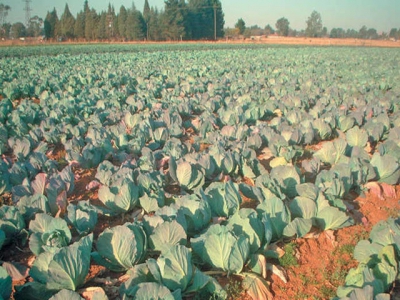Getting irrigation right

Farmers often ask me how frequently and how much they should irrigate. There is no simple answer, as many aspects must first be considered.
The pinkish cabbages in this land are a result of the nitrogen leaching below the root zone. This can happen with over-irrigation. Photo: Bill Kerr
The root system
Irrigating the soil too far below the crop’s root system is pointless.
Applying more water than needed could leach nutrients such as nitrate to beyond the reach of the roots.
Added to this is the expense of extra pumping.
The root systems of carrots, for example, go down beyond a depth of 2m. This may seem excessive, as the carrot is only about 25cm long, but deep roots have a significant advantage.
The deeper they go, the greater the volume of soil available for sourcing water and nutrients.
For the farmer, this means that irrigation timing is less critical, making management much easier. Moreover, carrots can utilise rainwater for longer than plants with shallow root systems, saving on pumping costs.
With this crop, controlling the depth of each irrigation and inducing a little stress between irrigations will encourage the roots to tap into nutrients that have leached deeper down.
This will save water, and a farmer may not even have to apply fertiliser if carrots follow another vegetable crop in rotation.
All this will help to yield longer, better quality carrots.
Frequency
Some farmers use a set routine, applying a certain amount of water at fixed intervals. But a crop’s water requirements differs at various growth stages, so this approach is flawed.
A newly planted crop, for example, lacks the root system to source moisture deeper down, and therefore needs lighter, more frequent irrigation.
This is especially so with transplants; they require light irrigation to replace moisture lost in the planter plug medium containing most of the roots. And irrigating more than necessary simply leaches the nitrate.
These young plants may be planted in the same land as older plants with deeper root systems and more leaves.
They transpire and remove more water than the young plants can, yet the latter often receive the same amount of water in every irrigation, increasing cost while production drops.
Soil type
Sandy soil has a limited water- holding capacity, while clay soil can hold substantially more. Therefore, sandy soil should be irrigated more often. The same amount of water will sink far deeper than in clay or loam soil.
Organic content
The organic content of the soil is important too. Two lands of the same soil type alongside each another may have a high and a low humus content respectively.
Because humus acts as a sponge, absorbing water, the land with a high humus content will respond like a clay soil, with less depth of wetting but more water retained per soil volume unit.
Related news
 Know your spinach variants
Know your spinach variants Chard (Beta vulgaris) is also known as ‘Swiss chard’, ‘silver beet’, ‘mangold’ and other names. In South Africa it is usually referred to simply as ‘spinach’.
 Dealing with eelworm
Dealing with eelworm There are a number of species to contend with; the common root knot genera (Melodogyne spp.) are easy to identify as the nematode enters the root and causes
 Crop problems: look for the clues!
Crop problems: look for the clues! We recently discussed how to identify mineral deficiencies and eelworm infestation. Many other problems can occur, of course.